Home » Indoor Sports Court » Gymnasium flooring options: how to pick the right material?
Gymnasium flooring options: how to pick the right material?
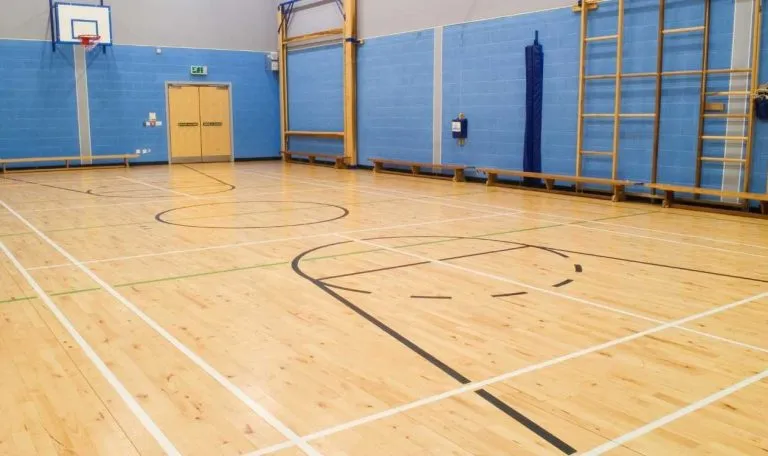
When looking at gymnasium flooring options, clubs, municipalities and sports complex operators are not lacking for choices. A wide range of manufacturers provide an even wider selection of products to meet the requirements of different sports.
The majority of popular indoor sports floors can be installed without hesitation for most athletic purposes in gymnasiums, sports centers and multi-purpose facilities. Other criteria for selecting the floor include suitability for installing a floor heating under the system, or visitor experience features such as sound insulation.
An overview of the various sports flooring systems and their suitability for different sports is given in the following overview. You can use our gym flooring cost calculator to get a cost estimate for different floor types. We can also connect you with some of the leading sports flooring builders in the US if you need more assistance.
Kick Off Your Gym Flooring Project
We’ve created a comprehensive set of tools designed to assist facility managers and project planners in initiating their projects and connect them with the professionals in the industry.
Gymnasium flooring options overview
Maple Hardwood Floor
Sports: Basketball.
Advantages: Expected life of 35-40 years, variety of system designs.
Maintenance: Daily dusting;, annual 1 x per year recoating, also HVAC monitoring and regular re-polishing required; floor protection needed in case of multiple uses.
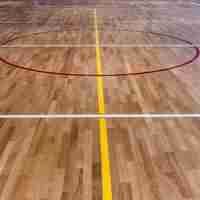
Sports Vinyl Floor
Sports: Basketball, volleyball and other activities.
Advantages: Good shock absorption and uniformity reduce risk of injury. Ideal for multi-purpose halls.
Maintenance: Low maintenance cost, no surface protection required, clean every one to two weeks with scrubber and detergent.
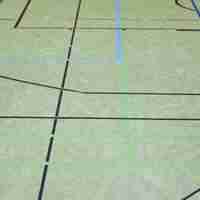
Sport Linoleum Floor
Sports: Can be used for a variety of purposes.in a variety of ways
Advantages: Lifespan of up to 50 years, environmentally friendly, well-suited for general-purpose gyms.
Maintenance/Care: Easy to maintain and repair. Cleaning with scrubber and detergent every 1-2 weeks. No surface protection required.
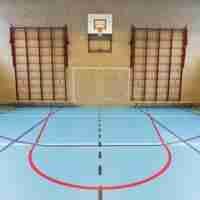
Vulcanized Rubber Floor
Sports: Multifunctional floor.
Advantages: Can be used with heavy equipment, even vehicles. Will withstand skates or spikes (depending on thickness).
Maintenance: Easy to repair and maintain, but harder to keep clean. No surface protection required.
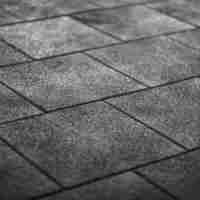
Pad & Pour Polyurethane Floor
Sports: Versatile
Advantages: Seamless surface suitable for heavy equipment; and withstands high point and rolling loads.
Maintenance: Polyurethane spray every 10 years, no surface protection required.
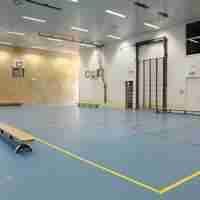
Combination System Floor
Sports: Basketball, volleyball, aerobics and others.
Advantages: Good shock absorption and very uniform, therefore reduced risk of injury;, multifunctional floor.
Maintenance: Regular dusting, cleaning every 1-2 weeks with scrubber and detergent, polyurethane spray every 3-5 years, no surface protection required.
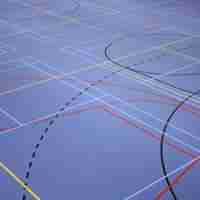
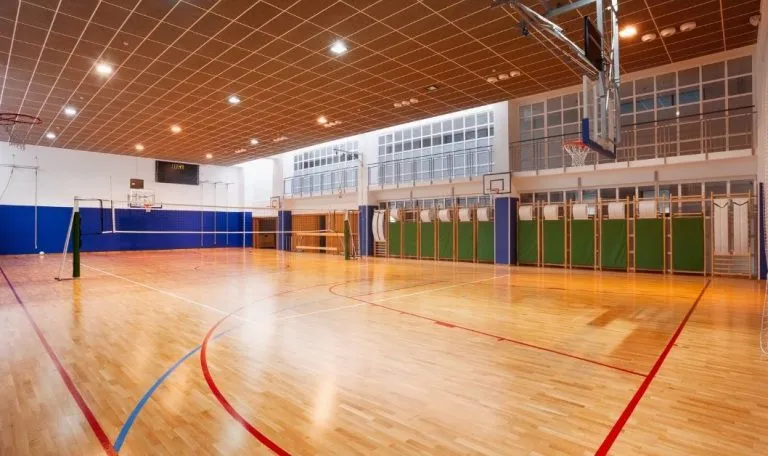
Establishing the use concept
Many gymnasiums are used for multiple purposes. A suitable indoor sports floor is a crucial basic requirement for training and competition purposes, and furthermore, if necessary, for events such as concerts or meetings. On the one hand, the sports floor in the indoor area must meet various sport-specific requirements. Criteria such as the slip and slip resistance of the hall floor, the ball bounce behavior, and the load-bearing capacity due to castors, for example of wheelchairs or equipment trolleys, must be taken into account. Overall, it is important to minimize the risk of injury during sports and to protect the joints as much as possible by choosing the right floor covering.
If the hall is also to be used for cultural events such as parties or concerts, this must also be taken into account by observing specific criteria. To maintain uniform standards when planning or renovating a sports hall, there are specifications from associations and institutions that define the requirements for sports floors, their construction, and testing and maintenance. Other standards apply to flooring work and define norms on topics such as fire protection or risk minimization through the use of harmless ingredients. The latter also takes into account the increased health and environmental awareness among the population. For example, the strict German requirements serve to control manufacturing processes and ingredients and thus to curb the import of inferior products from abroad.
Good impact sound insulation, the avoidance of disturbing light reflections or electrostatic charging, the possibility of installing underfloor heating and hygienic properties can be further selection criteria for the gymnasium floor. At the same time, the gymnasium floor should be as hard-wearing and durable as possible, and in terms of acquisition and maintenance costs, it should be good value for money.
Our gymnasium flooring cost calculator will help you determine the cost of your sports center floor.
Choosing the right gymnasium flooring material
Especially for new construction projects, you should use the following points to determine your needs around the new sports hall floor.
- Size of the gymnasium floor
What is the intended size of the hall? Pay particular attention to the specifications of the sports associations for match operations. For basketball, for example, should it be a half court or a full court, and what are the basketball-specific requirements?
- Which sports will be played?
Will the sports hall be used primarily by a club with one sport, such as basketball or volleyball? Or is it a multi-purpose hall where concerts and other events may be held in addition to a wide variety of sports and school classes? Based on the type of use, frequency of use, and expected soiling, it is possible to determine which surfaces to consider.
For example, Maple Hardwood is the standard surface for basketball. However, it is more expensive to purchase and not as versatile as other gymnasium flooring options.
- Budget and financing of the gymnasium floor
Already at the beginning of the planning phase, you should start thinking about the budget. In this context, it may become clear at an early stage that certain materials are out of the question for cost reasons. However, the focus should not only be on the budget for the sports floor. High-quality sports hall flooring has its price and in many cases a longer durability than supposedly low-cost sports flooring.
- Life cycle and durability of sports flooring
While engineered wood sports floors are characterized by a long life expectancy, synthetic sports floors require less maintenance. Both factors should be weighed against each other. The intensity of use and the type of activities should also be taken into account, as both also have an impact on wear.
However, not only the price should be converted to the total service life here. Rather, it should also be evaluated what quality the sports flooring still offers after a certain number of years.
- Care and maintenance of the sports floor
To maintain the quality of the sports hall floor, all floor coverings, whether wood or plastic, must be regularly maintained and cleaned. This includes sweeping or cleaning, and the immediate removal of heavy soiling, for example, from overturned drinks.
In addition, regular airing, heating and cooling, and checking for expansion or contraction of the floor are also necessary. On average, wood floors need to be sanded, painted and refinished after 10 to 15 years. Synthetic flooring requires frequent replacement after this period, but is less maintenance intensive until then.
In general, the wear marks caused by improper footwear cause the most wear and tear on synthetic sports floors.
- The subfloor in the sports hall
When choosing a subfloor, there are three main systems: floating, fixed and anchored. In addition, there are different variations in each case. Which subfloor is right for your hall depends, among other things, on the type and frequency of use.
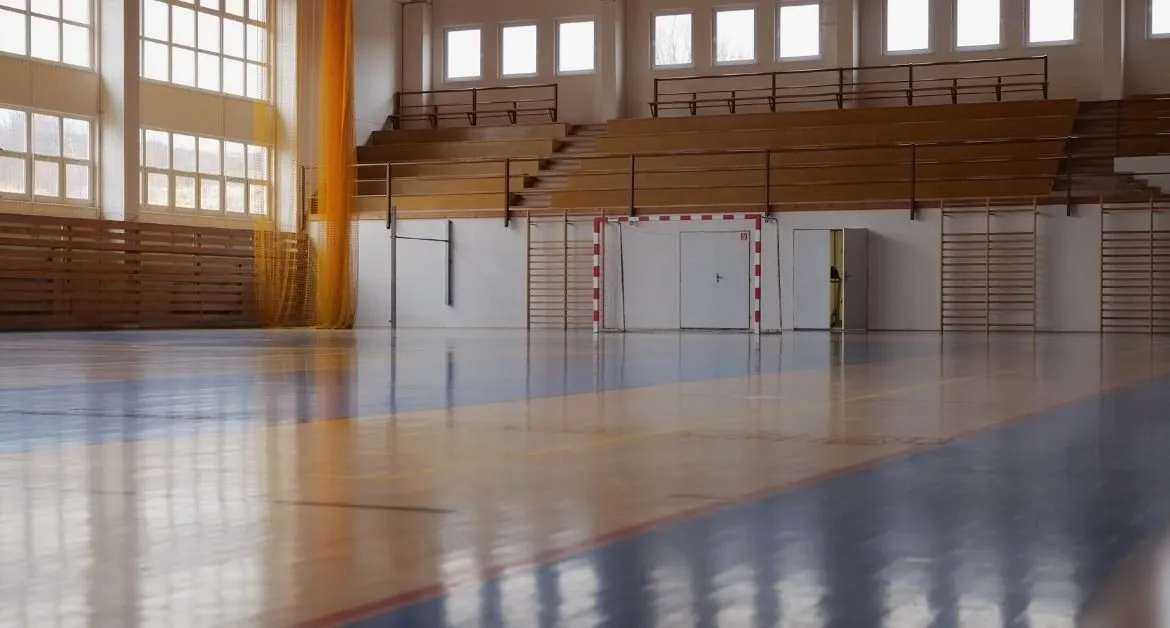
What are gymnasium floors made of in the US?
The following is a brief introduction to the most common gymnasium floor coverings in the United States. They have all been developed specifically for use as indoor sports flooring, are compliant with standards and are certified. These floor coverings have already proven their worth in countless gymnasiums.
- Maple Hardwood sports flooring can be found in many gymnasiums across the United States. A maple hardwood sports floor is dense, and its ball bounce and maintenance properties make it the ideal wood for sports floors. A parquet sports floor is also easy to maintain and durable. If the gym is used for multifunctional purposes, the parquet floor should be protected with an appropriate covering system during events.
- Sports linoleum as a gym floor is often the material of choice when it comes to a multi-purpose hall. Linoleum floors are extremely robust, available in various colors and can be found in sports centers across the country. Linoleum is also suitable for various roller sports.
- PUR-coated gymnasium flooring is a different variant from the two coverings mentioned so far. They can be applied on site in a liquid state and can be visually customized. With proper care, the gym floor can be used for several years, but must be resealed at regular intervals.
- PVC sports flooring, with a smooth or grained surface, is also a fairly durable floor covering and is available in a wide variety of colors.
- Although rubber is also an easy-to-clean gym flooring that is very similar to linoleum, it is rarely used in gymnasiums. One reason may be the costly installation of this indoor sports floor.
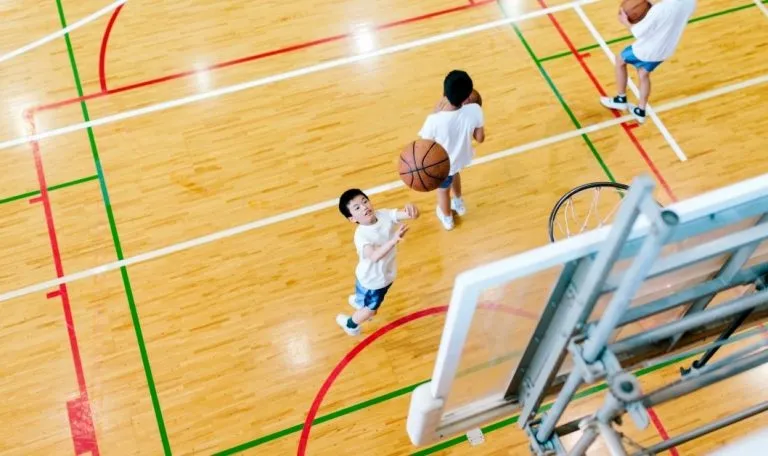
Kick Off Your Gym Flooring Project
We’ve created a comprehensive set of tools designed to assist facility managers and project planners in initiating their projects and connect them with the professionals in the industry.
Financing tips
Not every club or school can finance the replacement of a gym floor or the construction of a new sports complex on its own. As part of the financial planning, then, investigate whether subsidies or grants are possible. Municipal, state and federal level grants and tax credits are all common options.
The construction of an additional sports area or renovating an existing site should motivate club members or students and parents to get involved. Together, they can raise money through a fundraising campaign. Companies and individuals can be considered as potential donors, as can former players and students.
For more tips check out our guide to sports facility financing and funding.
Calculate costs - compare prices
When considering gymnasium flooring options, the costs play a decisive role. However, the lowest possible initial cost should not be the main factor when deciding to buy a gymnasium floor. A high-quality gymnasium floor can serve its purpose for several decades if well maintained. In addition to the use of high-quality materials, it is essential that the floor is installed in accordance with the relevant standards and by specialists.
When awarding a contract, therefore, it is not directly the cheapest offer that should win the contract; the client should also take a closer look at the references of the individual sports floor manufacturers. Make use of the possibilities for sports facility subsidies. Contact the relevant state sports association to find out which subsidy programs are currently running and which funds can be applied for.
The gymnasium flooring cost calculator can be used to calculate the costs for the gymnasium floor construction, including substructure, sports flooring, installation and disposal.

